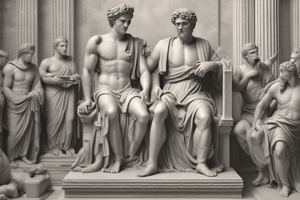Podcast
Questions and Answers
What period is characterized by the development of Athens as a major center of ceramic production?
What period is characterized by the development of Athens as a major center of ceramic production?
Geometric Period
What period saw the incorporation of exotic foreign motifs into native art?
What period saw the incorporation of exotic foreign motifs into native art?
Orientalizing Period
What period is known for large statues and the characteristic 'archaic smile'?
What period is known for large statues and the characteristic 'archaic smile'?
Archaic Period
Which period follows the Archaic Period in Greek history?
Which period follows the Archaic Period in Greek history?
What significant event began the Early Classical Period?
What significant event began the Early Classical Period?
What monumental structure was built during the High Classical Period?
What monumental structure was built during the High Classical Period?
What is a defining characteristic of the Late Classical Period?
What is a defining characteristic of the Late Classical Period?
What marks the beginning of the Hellenistic Period?
What marks the beginning of the Hellenistic Period?
What significant change occurred in 509 BCE in Roman history?
What significant change occurred in 509 BCE in Roman history?
What era is characterized by the rule of Augustus and development of roads in the empire?
What era is characterized by the rule of Augustus and development of roads in the empire?
What period follows the Early Empire and is characterized by significant architectural and cultural achievements?
What period follows the Early Empire and is characterized by significant architectural and cultural achievements?
What does the Late Empire characterize in terms of Roman history?
What does the Late Empire characterize in terms of Roman history?
Flashcards are hidden until you start studying
Study Notes
Geometric Period (900-600 BCE)
- Athens emerged as a significant center for ceramic production, focusing on organized abstract designs.
- Development of distinct architectural forms by the Greeks began, alongside active trade with eastern neighbors.
Orientalizing Period (700-600 BCE)
- Integration of foreign motifs into Greek art, reflecting cross-cultural influences.
Archaic Period (600-480 BCE)
- Characterized by the "archaic smile," a stylistic feature in large sculptures.
- Notable for the depiction of almond-shaped eyes in art.
Classical Period (480-323 BCE)
- A defining era in Greek culture marked by advancements in art, philosophy, and governance.
Early Classical Period (480-450 BCE)
- Commenced after the Persian sack of Athens, leading to the development of contrapposto in sculpture.
- Notable shift towards working with bronze material.
High Classical Period (450-400 BCE)
- Construction of the Parthenon, a monumental symbol of Athenian democracy and art.
Late Classical Period (400-323 BCE)
- Noteworthy for the decline of Athenian power and wildly expressive sculptures.
- The defeat of Athens by Sparta in 404 BCE marks a significant turning point.
Hellenistic Period (323-31/30 BCE)
- Initiated with the death of Alexander the Great, leading to diverse artistic expressions.
- End marked by the Battle of Actium in 31 BCE and the death of Cleopatra in 30 BCE.
- Distinctive for emotionally expressive artworks and a focus on the Corinthian order in architecture.
Etruscan Influence (700-509 BCE)
- Frescoes and craters in Etruscan tombs highlight Greek and Phoenician colony interactions in Southern Italy and Sicily.
- Rising demand for Greek-style art during Etruscan dominance.
Roman Republic (509-27 BCE)
- Established in 509 BCE after the overthrow of the last Etruscan king, transitioning to an oligarchic system.
- Complexity in governance arose as the empire expanded, leading to power concentration among a few leaders.
- Post-300 BCE, Greek bronze sculptures began to be reproduced in marble, signifying cultural exchange.
Early Empire (27 BCE-96 CE)
- Significant figures include Julius Caesar and Octavian (Augustus), who initiated infrastructure development like roads.
High Empire (96-192 CE)
- A period marked by stability and the peak of Roman architectural and cultural achievements.
Late Empire (192-312 CE)
- Characteristics of this era focused on sociopolitical challenges and transformations within the Roman state.
Roman Domestic Architecture
- Homes featured a vestibule leading into an atrium, which contained an impluvium for collecting rainwater, illustrating aspects of Roman domestic life and architectural design.
Studying That Suits You
Use AI to generate personalized quizzes and flashcards to suit your learning preferences.





